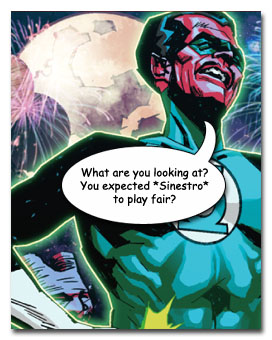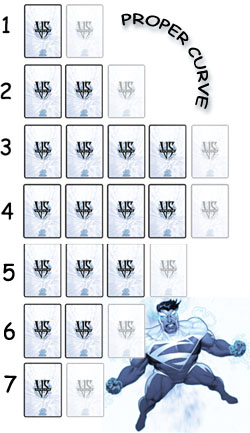
Anticipation. Ever since I heard the good news, I’ve been filled with it. I’ve been counting down the days until that magical time once again arrives. What time, you ask? Only the Christmas of the Vs. System universe—Sneak Peek time!
That’s right, ladies and gentlemen, the release of Justice League of America is right around the corner, and as usual, I can’t wait. I’m sure you guys are sick about hearing how excited I get by these things, but I really can’t help myself. Not only do I get the pleasure of playing with all the cool new cards, but I also get to do it in the confines of one of my all-time favorite formats, Sealed Pack.
I have been talking a lot about Draft recently, as I hope you already knew. With the Sneak Preview tournaments coming right around the bend, I think now is a good time to put a small Sealed Pack guide out there for everyone to look at.
Sealed Pack and Draft are two distinct and yet strikingly similar formats. They both involve building your deck on site from the sealed product you are given. They also follow many of the same guidelines in regard to deck construction. The major difference between the two formats is the lack of focus that most Sealed Pack decks have when compared to the average Draft deck, and that has a greater impact on the format than most people think.
First, I’d like to start with the similarities between the formats. I’m a teacher in addition to being a writer, so I understand the importance of repetition in learning. Most of what I’m going to give you here has been covered in much greater detail in “The Manual” article series, which I recommend you check out if you haven’t already. For now, however, I’ll give you a brief overview of evaluating card strength, building a proper curve, and correctly evaluating the format.
Going into a draft, most people already have a good idea of relative card strength. They have enough experience with the format to understand which cards are powerful enough to change the game and which are best left unplayed. In Sealed Pack, for the most part, this will also be true. But going into a Sneak Preview tournament, you will have no play experience under your belt, so the only information you will have is your opinion about the cards you saw discussed in previews and in the spoiler.
Correctly evaluating a card’s strength is an important part of a Sneak Preview tournament. Looking at the first picks section of “The Manual,” you get a good idea of what to look for in the powerful cards of a format. Plot twists that enhance or detract from a character’s ATK and/or DEF are very good and are usually the first cards considered for a deck. They are the deciding factor in many combat situations, so it’s pretty important to have them. You will also be looking for any team-up cards you were lucky enough to open. Having the ability to team attack and reinforce when your opponent doesn’t gives you a huge advantage, so you always want to include team-ups if they’re available. You also want to look for any cards that cement your board advantage. These would be plot twists that either remove an opponent’s character from the board or prevent yours from being KO’d. This helps you keep more characters in play than your opponent, which is a huge advantage as the turns progress.
Characters are another important thing to evaluate in a Sneak Preview tournament. The very first thing you should do is familiarize yourself with the major themes of the teams in the format. It would be really hard to tell how good a card like Panacea Potion was if you didn’t know that Squadron Supreme was all about zero hand size. If you know what each team is trying to accomplish, then you will know which cards do it well and which need to go back to team training. The next thing you’ll want to check is whether or not you  have any broken characters. This is a little difficult in an unestablished format, but there are a couple of things that can help you. First and most simply, many of the cards we’ll cover here at Metagame.com fall into the broken category. We like covering cards with unique effects and cards that highlight the main mechanics of the new set well. Look at our Avengers previews. We covered Captain America, Super Soldier, Black Panther, and Melissa Gold ◊ Songbird—not a bad set of characters, if you ask me. We can’t get to them all, though, so you will have to do some detective work on your own. My recommendation is to search for characters that are either extremely large for their cost, such as Melissa Gold ◊ Songbird, or those that break the rules of the game, such as Sinestro, Green Lantern of Korugar. This will get you moving in the right direction.
have any broken characters. This is a little difficult in an unestablished format, but there are a couple of things that can help you. First and most simply, many of the cards we’ll cover here at Metagame.com fall into the broken category. We like covering cards with unique effects and cards that highlight the main mechanics of the new set well. Look at our Avengers previews. We covered Captain America, Super Soldier, Black Panther, and Melissa Gold ◊ Songbird—not a bad set of characters, if you ask me. We can’t get to them all, though, so you will have to do some detective work on your own. My recommendation is to search for characters that are either extremely large for their cost, such as Melissa Gold ◊ Songbird, or those that break the rules of the game, such as Sinestro, Green Lantern of Korugar. This will get you moving in the right direction.
 Curve is as essential to Sealed Pack as it is to Draft, but there is a major difference. In Sealed Pack, there is no way to control the number of characters you have in a team or collection of teams at any given cost. This means that you may not be able to find three 5-drops in your teams of choice in your Sealed Pack. In situations like this, you will have to play characters from other team affiliations to fill your curve. It is much more important to have a proper curve than to try to stick to two teams in Sealed Pack. I really can’t stress that enough. If you take anything away from this article, please take that and always remember it. As a reminder to those who haven’t memorized it, the proper curve for an average Sealed Pack is one to two 1-drops, two to three 2-drops, four to five 3-drops, four to five 4-drops, three to four 5-drops, two to three 6-drops, and one to two 7-drops. Say that five times fast.
Curve is as essential to Sealed Pack as it is to Draft, but there is a major difference. In Sealed Pack, there is no way to control the number of characters you have in a team or collection of teams at any given cost. This means that you may not be able to find three 5-drops in your teams of choice in your Sealed Pack. In situations like this, you will have to play characters from other team affiliations to fill your curve. It is much more important to have a proper curve than to try to stick to two teams in Sealed Pack. I really can’t stress that enough. If you take anything away from this article, please take that and always remember it. As a reminder to those who haven’t memorized it, the proper curve for an average Sealed Pack is one to two 1-drops, two to three 2-drops, four to five 3-drops, four to five 4-drops, three to four 5-drops, two to three 6-drops, and one to two 7-drops. Say that five times fast.
The last similarity I want to discuss is the necessity of correctly evaluating the format. There are many questions you should ask yourself when looking at your card pool or the spoiler. How high are the average DEF values on characters? If they’re much higher than normal, the format tends to be much slower. This raises the value of the more expensive characters, so you may think about adding that 8-drop you opened. Are there viable cards for an off-curve strategy, and if so, does your Sealed Pack have the cards to support it? If the answer is yes to both questions, you should strongly consider building your deck around it. Recently, Sealed Pack formats have been very friendly to off-curve decks, mostly due to the lack of a card to control them. Unless a card like Flame Trap sees print, off-curve strategies should always be considered strongly as a possibility when constructing your deck. What do the major mechanics of the set hope to accomplish? This is a little harder to answer. The best example of this is reservist. Thanks to reservist, hands that were formerly unkeepable turned into excellent holdings. In short, reservist made Sealed Pack more consistent. Since consistency is essential to winning, reservist became a very powerful new mechanic. Look for something in the new set that has a highly favorable effect on the game and see if it’s possible to incorporate it into your Sealed Pack.
Despite having all of this in common, there is one major difference between Sealed Pack and Draft that should be painfully obvious because of the basic mechanical difference between the two formats. In Draft, you get to select the pool of cards from which you build your deck. In Sealed Pack, however, you don’t get that luxury. This means that Sealed Pack decks tend to be much less coherent and much broader in focus. It’s more common to see a Sealed Pack deck constructed solidly out of three teams than it is to see a Draft deck like that.
This lack of focus has a few major effects on the format. First of all, it makes the format a turn or two slower than a typical Draft. This stems from the overall quality of cards in each player’s deck being lower than if he or she had drafted. That has the effect of skewing the curve in favor of adding more expensive characters. In Sealed Pack, you should try to hit the upper range of characters for each drop past the 5-drop and might even want to consider adding an 8-drop into the mix if you’re lucky enough to open one. Another important effect it has is to raise the value of team-up cards. They become indispensable as the format gets more diluted. I repeat: the ability to team attack and reinforce when your opponent can’t is a huge advantage. Build your deck accordingly and you’ll be well on your way to victory.
That’ll be it for this week, kiddos. With the Sneak Preview tournaments coming up fast, we’ll be starting previews before you know it. Stay tuned to Metagame.com for all the hot preview action you can handle. And don’t forget what you read here—you’ll need it at the Sneak Preview tournament.
Questions and comments can be sent to the_priceis_right@yahoo.com. If you’ve written me and I haven’t responded, I apologize, but you can expect replies soon.